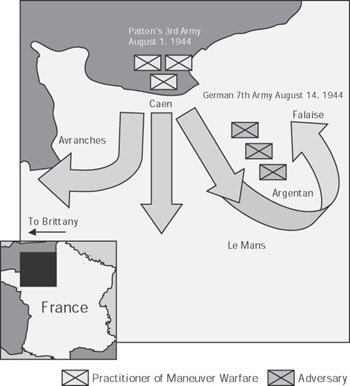Chapter 8: Decentralized Decision Making
Overview
Never tell people how to do things. Tell them what to do, and they will surprise you with their ingenuity.
”General George S. Patton [1]
Decentralized decision making ”the delegation of significant decision making authority down through the ranks ”allows a military force to cope with the unforeseen events and confusion that are inherent in competitive encounters, to generate a superior tempo of operations, and to exploit opportunities as they arise. [2]
The aim is to give those closest to the action the latitude to take advantage of on-the-spot information unavailable to their superiors. While midlevel and frontline leaders are strongly encouraged to make decisions on their own and act on them, their actions must be consistent with the organization s overall objectives. To this end decentralized decision making relies heavily on the commander s intent ”the leader s desired final result ”to define the scope of initiative that subordinates can exercise.
A risk-reward trade-off in its own right, decentralized decision making can deliver breakthrough results by increasing the likelihood of nonlinear accomplishments ”situations in which an extraordinary act by an individual disproportionately determines the course of large-scale competitive encounters. But it also carries considerable risk: distributed authority is, by nature, chaotic and can result in a higher prevalence of mistakes, especially when overzealous junior leaders do not act in concert with the commander s intent. To reap the full rewards of decentralized decision making, the leader must be willing to trust the capabilities of his or her subordinates, relinquish some degree of control, and resist the temptation to intervene when execution is not as precise as he or she would like. At the same time, to mitigate the risks inherent in distributed authority, leaders must obtain accurate factual assessments quickly, correct mistakes on the spot, and be ever-vigilant for anything that could cause catastrophic failures.
In this chapter we offer four examples of decentralized decision making and its key components , as well as present-day lessons from the Marines. George Patton s Normandy Breakout in 1944 illustrates successful decentralized decision making in warfare . London-based Smith Newcourt s management of its trading business illustrates not only successful decentralized decision making in a high-stakes, fast-paced business environment but also the absolute importance of correcting mistakes on the spot in a positive, reinforcing manner. U.S. Marine colonel (ret.) John Ripley s heroism at the Bridge at Dong Ha in Vietnam in 1972 exemplifies how a nonlinear accomplishment can be a potential outcome of decentralized decision making. Finally, the fall of Applied Energy Systems (AES) over the last three years serves as an unfortunate example of decentralized decision making gone wrong.
In stark contrast to its widely held image as a rigid, top-down military hierarchy, the Marine Corps has embraced decentralized decision making as indispensable to battlefield success. Emulating some or all of the Marines practices can enable you to unleash the power of this fifth guiding principle of maneuver warfare in your organization. Our intent in this chapter is to use their experiences and some of the lessons learned from our historical examples to suggest ways in which you can establish a baseline of trust in your organization, train your people to make decisions confidently in your absence, communicate in a manner that provides your people with the bigger picture, supervise the implementation of your directions, and use technology to share information throughout your organization.

Figure 8.1: Patton s Normandy Breakout, 1944
[1] www.generalpatton.com.
[2] Warfighting , 78.
EAN: 2147483647
Pages: 145